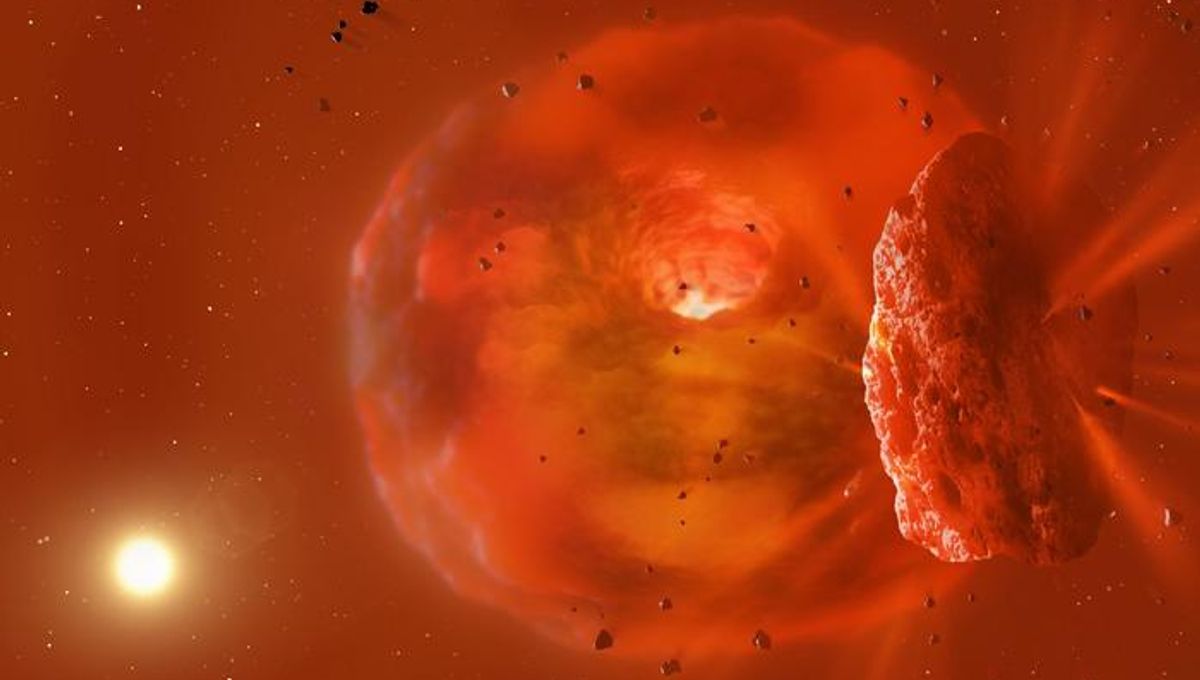
Astronomers have tracked the sudden brightening of a star in infrared light, and its subsequent optical fade, as a result of an immense collision of two mighty planets. They’ve even spotted light thought to come from the puffed-up planet formed in the collision.
In December 2021 the previously unremarkable star 2MASS J08152329-3859234 became substantially fainter to telescopes operating in visible light. Such events have been seen before, but remain rare enough to draw astronomers’ attention. The star was renamed ASASSN-21qj and additional telescopes around the world devoted time to checking up on it regularly.
Then, however, came a comment on social media that took this from an unusual but not exceptional event to something unprecedented. Nine hundred days earlier, it was noted, ASASSN-21qj had got dramatically brighter at infrared wavelengths, and stayed that way until after the optical dimming began.
“To be honest, this observation was a complete surprise to me,” said Dr Matthew Kenworthy of Leiden University, co-lead author of a new study, in a statement.
The combination of extra infrared and reduced optical light is what we would expect to see if something had created an enormous cloud of dust. At first, the dust cloud was not in our line of sight to the star, but radiation from ASASSN-21qj heated it to 1,000 K (1,340 °F) causing it to glow in the infrared. Eventually, the cloud passed between Earth and the star, blocking enough of its light to cause the fading at visible wavelengths. Around 100 days after the dimming started the infrared radiation started to fade, but the timing is thought to be a coincidence.
Kenworthy and colleagues have conducted a detailed analysis to work out the amount of dust and its likely orbit, to determine the size of the planets involved and their locations relative to ASASSN-21qj.
They conclude the collision involved two planets larger than Earth, probably ice giants similar to Neptune and Uranus, a sort of Ragnarök civil war. The objects encountered each other between 2 and 16 astronomical units from ASASSN-21qj, a range that in our Solar System would span from a little beyond the orbit of Mars out nearly to Uranus.
As time goes on it is anticipated the dust will spread out around its orbit, like the trails from comets that produce meteor showers. Further observations of this process should help refine the estimates of the compositions of the planets involved and their orbits.
Despite the immense amount of dust produced, approximately 99 percent of the masses of the two planets would be incorporated into a new planet, and the team has detected light they think is from this new world. Vaporization caused by the heat released in the collision will have initially caused the planet to puff up to many times its size, from which it will gradually condense, but in the meantime, it reflects enough for us to see.
“Ultimately, the mass of material around the remnant may condense to form a retinue of moons that will orbit around this new planet,” said Dr Zoe Leinhardt of the University of Bristol.
ASASSN-21qj is a young star, which the team estimates to be 300 million years old. If so, this puts it outside the initial planet-forming period, but it may be experiencing something like the Solar System’s Late Heavy Bombardment. Nevertheless, encounters on this scale are exceptional. Previously spotted dust clouds may also be from collisions, but were probably much smaller, and did not produce a planet we can see.
The study is published in Nature.
Source Link: Afterglow Of Giant Planets Colliding Captured For The First Time